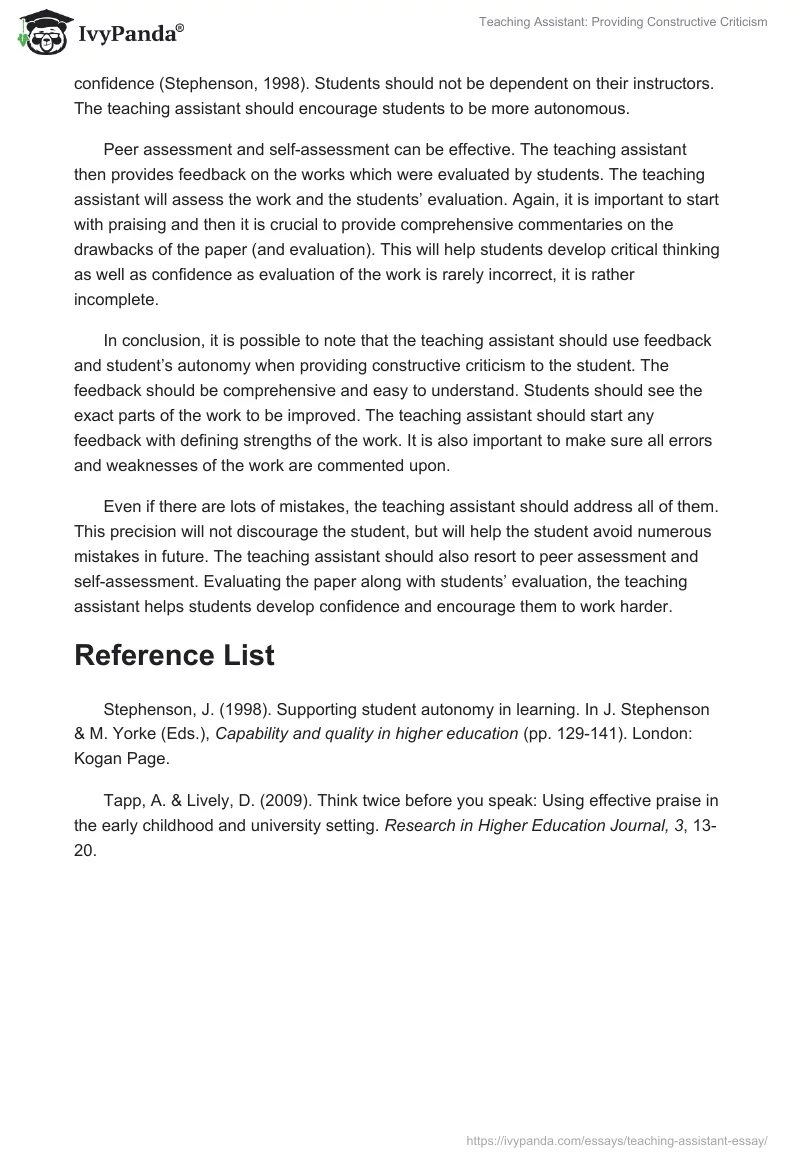Researchers admit that it is vital to instill confidence in students. However, it can be difficult to instill confidence and provide constructive criticism to the student. Teaching assistant should exploit a variety of tools to achieve this goal. Some of the most effective tools are various types of feedback and development of students’ autonomy.
Tapp and Lively (2009) note that effective feedback is one of the most potent tools to provide constructive criticism and praise students. Thus, the teaching assistant should provide specific feedback on each assignment given to students. The feedback should consist of two parts. First, the teaching assistant should praise the student’s work defining the strongest parts of the work. After that, it is crucial to define the weakest points.
Of course, criticism should not be insulting. It can be a good idea to put leading questions which can help the student improve the work. It is necessary to encourage the student to provide an in-depth research on the matter. The teaching assistant should also show particular parts of the work to improve. Importantly, each assignment should be evaluated as students feel that their effort is appreciated and valued (Tapp & Lively, 2009).
Tapp and Lively (2009) also claim that it is important to look for something positive in any work. Students should not be discouraged by the instructor’s comments. Novice teaching assistants often make a big mistake. They try not to discourage students by providing incomplete criticism.
In other words, they simply discuss only some mistakes ignoring the rest of errors made by students. Another mistake is that teaching assistants provide quite vague comments. This is an ineffective practice. It is important to comment upon each error and each weak place. At that, the teaching assistant should provide comprehensive and clear commentaries so that the student can easily use the commentaries in future.
Developing students’ autonomy can also be effective as this will help the teaching assistant provide constructive criticism and, at the same time, help the student develop confidence (Stephenson, 1998). Students should not be dependent on their instructors. The teaching assistant should encourage students to be more autonomous.
Peer assessment and self-assessment can be effective. The teaching assistant then provides feedback on the works which were evaluated by students. The teaching assistant will assess the work and the students’ evaluation. Again, it is important to start with praising and then it is crucial to provide comprehensive commentaries on the drawbacks of the paper (and evaluation). This will help students develop critical thinking as well as confidence as evaluation of the work is rarely incorrect, it is rather incomplete.
In conclusion, it is possible to note that the teaching assistant should use feedback and student’s autonomy when providing constructive criticism to the student. The feedback should be comprehensive and easy to understand. Students should see the exact parts of the work to be improved. The teaching assistant should start any feedback with defining strengths of the work. It is also important to make sure all errors and weaknesses of the work are commented upon.
Even if there are lots of mistakes, the teaching assistant should address all of them. This precision will not discourage the student, but will help the student avoid numerous mistakes in future. The teaching assistant should also resort to peer assessment and self-assessment. Evaluating the paper along with students’ evaluation, the teaching assistant helps students develop confidence and encourage them to work harder.
Reference List
Stephenson, J. (1998). Supporting student autonomy in learning. In J. Stephenson & M. Yorke (Eds.), Capability and quality in higher education (pp. 129-141). London: Kogan Page.
Tapp, A. & Lively, D. (2009). Think twice before you speak: Using effective praise in the early childhood and university setting. Research in Higher Education Journal, 3, 13-20.


